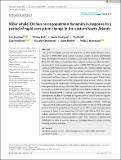Killer whale (Orcinus orca) population dynamics in response to a period of rapid ecosystem change in the eastern North Atlantic
Abstract
This study investigates survival and abundance of killer whales (Orcinus orca) in Norway in 1988-2019 using capture-recapture models of photo-identification data. We merged two datasets collected in a restricted fjord system in 1988-2008 (Period 1) with a third, collected after their preferred herring prey shifted its wintering grounds to more exposed coastal waters in 2012-2019 (Period 2), and investigated any differences between these two periods. The resulting dataset, spanning 32 years, comprised 3284 captures of 1236 whales, including 148 individuals seen in both periods. The best-supported models of survival included the effects of sex and time period, and the presence of transients (whales seen only once). Period 2 had a much larger percentage of transients compared to Period 1 (mean = 30% vs. 5%) and the identification of two groups of whales with different residency patterns revealed heterogeneity in recapture probabilities. This caused estimates of survival rates to be biased downward (females: 0.955 ± 0.027 SE, males: 0.864 ± 0.038 SE) compared to Period 1 (females: 0.998 ± 0.002 SE, males: 0.985 ± 0.009 SE). Accounting for this heterogeneity resulted in estimates of apparent survival close to unity for regularly seen whales in Period 2. A robust design model for Period 2 further supported random temporary emigration at an estimated annual probability of 0.148 (± 0.095 SE). This same model estimated a peak in annual abundance in 2015 at 1061 individuals (95% CI 999-1127), compared to a maximum of 731 (95% CI 505-1059) previously estimated in Period 1, and dropped to 513 (95% CI 488-540) in 2018. Our results indicate variations in the proportion of killer whales present of an undefined population (or populations) in a larger geographical region. Killer whales have adjusted their distribution to shifts in key prey resources, indicating potential to adapt to rapidly changing marine ecosystems.
Citation
Jourdain , E , Goh , T , Kuningas , S , Similä , T , Vongraven , D , Karoliussen , R , Bisther , A & Hammond , P S 2021 , ' Killer whale ( Orcinus orca ) population dynamics in response to a period of rapid ecosystem change in the eastern North Atlantic ' , Ecology and Evolution , vol. Early View . https://doi.org/10.1002/ece3.8364
Publication
Ecology and Evolution
Status
Peer reviewed
ISSN
2045-7758Type
Journal article
Description
Fieldwork and study conducted by SK received financial support by the University of St Andrews studentship, SMRU Ltd., the Russell Trust Award and from the Finnish-Norwegian Cultural Foundation.Collections
Items in the St Andrews Research Repository are protected by copyright, with all rights reserved, unless otherwise indicated.

